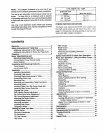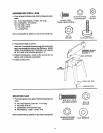
BEFORE STARTING
1. TO avoid kickbacks and slips into the blade, make
sure the Rip Fence is parallel to the sawblade.
2. Check the anti-kickback pawls. (See "BASIC SAW
OPERATION - USING THE RIP FENCE.") The
Pawls must stop a kickback once it has started.
Replace or sharpen Anti-Kickback Pawls when points
become dull.
3. Plastic and composition (like hardboard) materials
may be cut on your saw. However, since these are
usually quite hard and slippery, the Anti-Kickback
Pawls may not stop a kickback. Therefore, be espe-
cially careful in your set-up and cutting procedures.
WHILE CUTTING
1. To avoid kickbacks and slips into the blade, always
push forward on the section of the wo rkpiece between
the saw blade andthe Rip Fence. Never push forward
on the piece being cut off.
ADDITIONAL iNSTRUCTIONS FOR
CROSSCUT TYPE CUTS
BEFORE STARTING
1. NEVER use the Rip Fence when crosscutting.
2. An auxiliary wood facing attached to the Miter Gauge
can help prevent workpiece twisting and throwbacks.
Attach itto the holes provided. Make the facing long
enough and big enough to support your work. Make
sure, however, it will not interfere with the Sawblade
Guard. (See page 26)
3. Use jigs or fixtures to help hold any piece too small to
extend across the full length of the Miter Gauge face
during the cut. This lets you properly hold the Miter
Gauge and workpiece and helps keep your hands
away from the blade.
WHILE CUTTING
1. To avoid blade contact, always hold the Miter Gauge
as shown in the "BASIC SAW OPERATIONS - US-
ING THE MITER GAUGE."
BEFORE LEAVING THE SAW
1. Turn the saw off.
2. Wait for blade to stop spinning.
3. Make workshop child-proof. Lock the shop. Discon-
nect master switches. Remove the yellow Switch
Key. Store _ away from children and others not
qualified to use the tool.
4. Unplug the saw.
glossary of terms for woodworking
Anti-Kickback Pawls (AKP)
Device which, when properly maintained, isdesigned to
stopthe workpiece from being kicked back at the opera-
tor during dpping operation.
Arbor
The shaft on which a cutting tool is mounted.
Crosscut
A cutting or shaping operation made acrossthe width of
the workpiece.
Dado
A non through cutwhich produces a square sided notch
or trough in the workpiece.
Featherboard
A device which can help guide workpieces during rip
type operation.
Freehand
Performing a cut without using a Fence, Miter Gauge,
fixture, hold down or other proper device to keep the
workpiece from twisting during the cut.
Gum
A sticky, sap based residue tram wood products.
Heel
Misalignment of the blade.
Kerr
The amount of material removed by the blade in a
Kickback
An uncontrolled grabbing and throwing ofthe workpiece
back toward the front of the saw.
Leading End
The end of the workpiece which, during a rip type
operation, is pushed into the cutting tool first.
Molding
A non through cutwhich produces a special shape inthe
workpiece used for joining or decoration.
Push Stick
A device used to feed the workpiece through the saw
during narrow ripping type operations and helps keep
the operator's hands well away from the blade.
Push Block
A device used for ripping type operations too narrow to
allow use of a Push Stick.
Rabbet
A notch inthe edge of a workpiece.
Resin
A sticky, sap base substance that has hardened.
Ripping
A cutting operation along the length of the workpiece.
Revolutions Per Minute (RPM)
The number of turns completed by a spinning object in
one minute.
through cut or the slot produced by the blade in a non
through or partial cut.


















